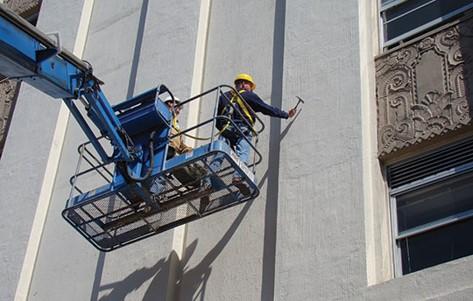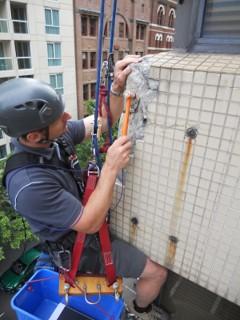Case 2
- Introduction
- Causes of Defects
- Good Practices
- Standards
- Maintenance and Diagnostics
- Remedial
- Similar Cases
- References
Maintenance and Diagnostics
Maintenance
Masonry requires periodic maintenance to ensure its continued successful performance.
Although the brick units are quite durable over time, other materials in the wall system will require periodic repair and/or replacement.
Typical maintenance items which should be addressed are repairing of cracks in masonry, cleaning clogged weep holes, removing stains and efflorescence, repainting steel, replacing caps or copings, repointing mortar joints (tuckpointing), replacing deteriorated sealants and caulking, and cleaning the masonry.
Brick masonry can generally be cleaned with chemical solutions in conjunction with water rinsing. Acidic cleaners containing dilute mineral acids such as hydrochloric, hydrofluoric, phosphoric and/ or organic acids such as acetic and citric are used to remove heavy soiling from most brick masonry.
The cleaning process involves applying the diluted cleaner to the pre-wetted surface and allowing a short dwell period. Chemical and soiling residues are removed by pressure water rinsing. Great care should be used to avoid damage to mortar, which can be attacked by acids. Sometimes alkaline cleaners are used to remove soiling on brick surfaces, but the type of chemical cleaner should be selected with care, then tested in small areas before it is applied in whole to the walls. Certain chemicals cause staining of some types of bricks, and soft brick are particularly vulnerable to damage from aggressive cleaning methods (Table 1).
| Condition of Brick wall | Cleaning method |
| Dirt on brick Smooth textured bricksModerately rough texture Very rough texture Walls with coloured mortar joints | Scouring powder and a stiff brush. Where budget allows, high pressure steam (< 60 psi) with detergent allows faster cleaning. Scrubbing with an oxalic acid-ammonium biflouride solution Pressurized water cleaning (< 700 psi) Mild detergent solutions. Acids may bleach coloured mortar. |
| Biological stain | Apply sulpharnate or weed killer. |
| Green Stains from Vanadium salts | Flush brickwall with water followed by solution of potassium or sodium hydroxide. Allow it to stand for 3 days. Hose off remaining white salt on the brickwall from the hydroxide. |
| Paint on wall | Chemicals and high-pressure steam or scrubbing with steel. wool. |
| Walls with efflorescence | Generally disappear with normal weathering. Can be removed by dry brushing or with clear water and a stiff brush. Heavy accumulation requires proprietary cleaner. |
| Grayish- white haze (White scum) | Masking by solutions of paraffin oil and Varsol, or linseed oil and Varsol, applied by brush to the affected brick units. |
Table 1: Cleaning method for different types of stains.
Diagnostics of Defect (see also NDT)
Hammer Tapping Test
Tapping test may be used to detect hollowness, delamination, spalled or debonded plaster.by listening to the ‘void’ sound.



Moisture meter is used to determine the presence of moisture. Moisture readings can be taken within masonry walls, dry walls, insulation, concrete members, roofing, wood construction, and other building components.
